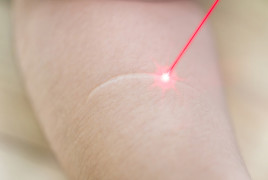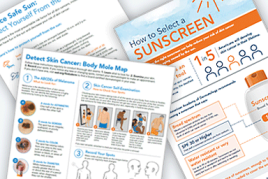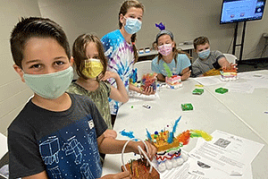Prurigo nodularis: FAQs
What is prurigo nodularis?
Prurigo nodularis is an intensely itchy skin condition. Scratching causes hard, itchy bumps called nodules to appear on your skin. Dermatologists offer treatment that can relieve the ongoing itch, allowing your skin to heal.
Is prurigo nodularis contagious?
No. While the scratching and resulting rash of bumps may remind you of a contagious disease, you cannot catch prurigo nodularis or give it to someone.
Nodules of prurigo nodularis on the legs and arms
The intensely itchy bumps (aka nodules) often develop on skin that’s easy to scratch like the legs and arms. The bumps may be red, pink, the color of your skin, or brownish black. The itchy bumps can break open or scab over.

How does prurigo nodularis start?
This skin condition begins with itchy skin. You may have 1 or 2 small areas of itchy skin, or widespread itch. The itch can come in short, intense bursts or be present most of the time.
When your skin itches, it causes an uncontrollable urge to scratch and rub. After scratching or rubbing for a while, hard bumps called nodules appear. The nodules are also intensely itchy, so you continue to scratch.
Some people scratch until the itchy nodules break open and bleed or their skin feels too painful to touch. Frequent scratching can also cause scrapes and tears on the skin. The open and injured skin may become infected.
Can prurigo nodularis spread?
Scratching often causes more bumps to appear. While you may see more bumps, this is due to inflammation. You are not spreading the prurigo nodularis around on your skin.
Keep in mind, the more you scratch, the worse the itch. As you continue to scratch the intensely itchy bumps and patches, more bumps or larger patches may appear. This creates an ongoing cycle of itching and scratching. Your dermatologist may refer to this as the itch-scratch cycle. Treatment can break this cycle.
How do you get rid of prurigo nodularis?
To get rid of prurigo nodularis, you need to treat it.
A board-certified dermatologist can help by creating an individualized treatment plan. This plan focuses on treating the itch and inflammation (response in your body that harms healthy tissue). To help patients feel more comfortable, the plan often includes tips for relieving the itch.
Treatment can take time to work, and you may need to try different treatments to get relief. Sometimes treatment fails to work, and prurigo nodularis lasts for years. This is less common today thanks to research breakthroughs.
Breakthroughs have led to FDA-approved medications, which are giving patients significant relief from the itch and reducing the number of bumps on their skin. This, in turn, is improving life for many people who were living with long-lasting itching, bumps, and pain.
For more information about how dermatologists treat this condition, go to Prurigo nodularis: Diagnosis and treatment.
Is there a cure for prurigo nodularis?
At this time, prurigo nodularis can be treated but not cured. Effective treatment can get rid of the itch and clear your skin.
Is prurigo nodularis an autoimmune disease?
No. Prurigo nodularis is not considered an autoimmune disease.
A person develops an autoimmune disease when their body mistakes a part of itself as an invader and attacks. For example, psoriasis is an autoimmune disease because T-cells, which are part of the immune system, mistakenly attack healthy skin cells.
When someone develops prurigo nodularis, the body doesn’t mistakenly attack a part of itself. For more information about what causes this skin condition, go to Prurigo nodularis: Causes.
Is prurigo nodularis hereditary?
“Hereditary” means a person has an increased likelihood of developing a disease because they have certain genes, which they have inherited from their parents.
You cannot inherit genes for prurigo nodularis, so this skin condition is not hereditary.
Can prurigo nodularis kill you?
No. This skin condition won’t kill you, but it can greatly affect your life. People living with prurigo nodularis say that the disease can negatively impact their life in many ways.
How many of these ways can you identify with?
Interrupted sleep due to the itch: Many say they never get enough sleep because the intense itch wakes them. As a result, most days they feel tired and groggy.
Missed days of work or school: Not getting enough sleep can make it difficult to do your best at work or school. Sometimes, people just don’t have the energy to do their job. Others feel too embarrassed by the constant scratching, which can cause bleeding through their clothes, so they miss days at work or school.
Canceling plans for getting together with friends or family: Some patients lose interest in being around others. They say they feel ashamed, embarrassed, or both. Some reveal that family members feel embarrassed by them.
These sentiments leave many with prurigo nodularis wanting to be by themselves. Many patients say that since getting prurigo nodularis, they have become shyer, feel uncomfortable around people, and no longer have the energy to enjoy social activities.Feeling distressed, anxious, or angry: Prurigo nodularis can last a long time, sometimes years. Living with intense itch, itchy bumps, and other symptoms can cause a range of feelings from distress to anger. Some say the itch drives them crazy.
Living with stress levels on overdrive: When skin itches most of the time and nodules don’t go away, it can cause people to feel a great deal of stress. For some people, stress also triggers flare-ups.
Your dermatologist knows how to create a treatment plan that can reduce symptoms, allowing you to sleep, feel less stressed, and focus on your life instead of your itchy skin.
To learn more about the symptoms and where this disease can develop on the body, go to Prurigo nodularis: Signs and symptoms.
Images
Image 1: Used with permission of the Journal of the American Academy of Dermatology:
2001 Mar;44(3):471-8.
Image 2: Used with permission of JAAD Case Reports:
2019 May 8;5(5):471-3.
References
Chao, TJ. “A rapidly changing landscape in prurigo nodularis signals new directions and opportunities for treatment.” Dermatol Times 2024 Dec 23.
Huang AH, Williams KA, et al. “Prurigo nodularis: Epidemiology and clinical features.” J Am Acad Dermatol. 2020 Dec;83(6):1559-65.
Kim B, Rothenberg ME, et al. “Neuroimmune interplay during type 2 inflammation: Symptoms, mechanisms, and therapeutic targets in atopic diseases.” J Allergy Clin Immunol. 2024 Apr;153(4):879-93.
Leis M, Fleming P, et al. “Prurigo nodularis: Review and emerging treatments. Skin Therapy Lett. 2021 May;26(3):5-8.
Mollanazar NK, Sethi M, et al. “Retrospective analysis of data from an itch center: Integrating validated tools in the electronic health record.” J Am Acad Dermatol. 2016 Oct;75(4):842-4.
Rodriguez D, Kwatra SG, et al. “Patient perspectives on living with severe prurigo nodularis.” JAMA Dermatol. 2023 Nov 1;159(11):1205-12.
Todberg T, Zachariae C, et al. “Treatment and burden of disease in a cohort of patients with prurigo nodularis: A survey-based study.” Acta Derm Venereol. 2020 Apr 21;100(8):adv00119.
Watsky K (author), Fowler J (section editor). “Prurigo nodularis.” UpToDate. Last updated August 21, 2024. Last accessed January 15, 2025.
Whang KA, Le TK, et al. “Health-related quality of life and economic burden of prurigo nodularis.” J Am Acad Dermatol. 2022 Mar;86(3):573-80.
Written by:
Paula Ludmann, MS
Reviewed by:
Brendan Camp, MD, FAAD
Raj Chovatiya, MD, PhD, FAAD
Brian Kim, MD, FAAD
Ata Moshiri, MD, FAAD
Carla Torres-Zegarra, MD, FAAD
Last updated: 4/1/25
 Atopic dermatitis: More FDA-approved treatments
Atopic dermatitis: More FDA-approved treatments
 Biosimilars: 14 FAQs
Biosimilars: 14 FAQs
 How to trim your nails
How to trim your nails
 Relieve uncontrollably itchy skin
Relieve uncontrollably itchy skin
 Fade dark spots
Fade dark spots
 Untreatable razor bumps or acne?
Untreatable razor bumps or acne?
 Tattoo removal
Tattoo removal
 Scar treatment
Scar treatment
 Free materials to help raise skin cancer awareness
Free materials to help raise skin cancer awareness
 Dermatologist-approved lesson plans, activities you can use
Dermatologist-approved lesson plans, activities you can use
 Find a Dermatologist
Find a Dermatologist
 What is a dermatologist?
What is a dermatologist?